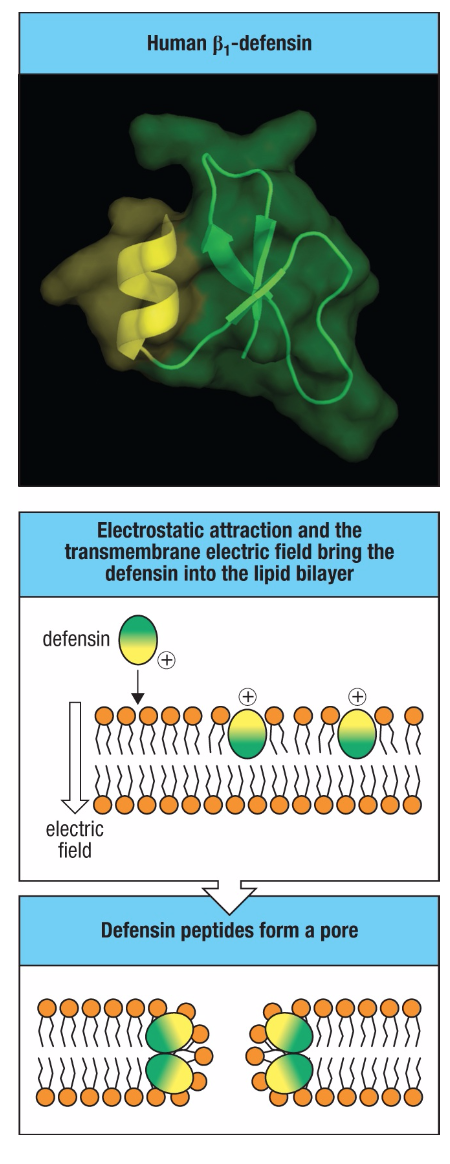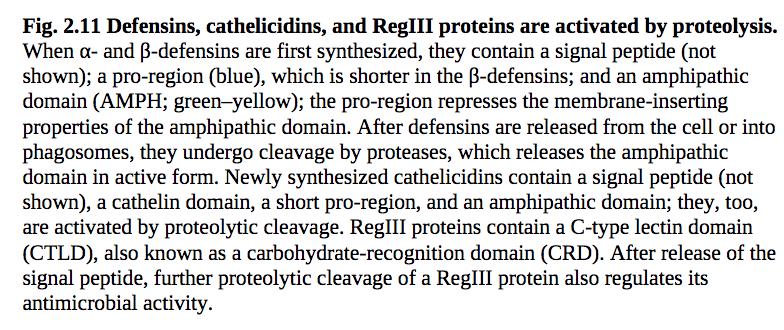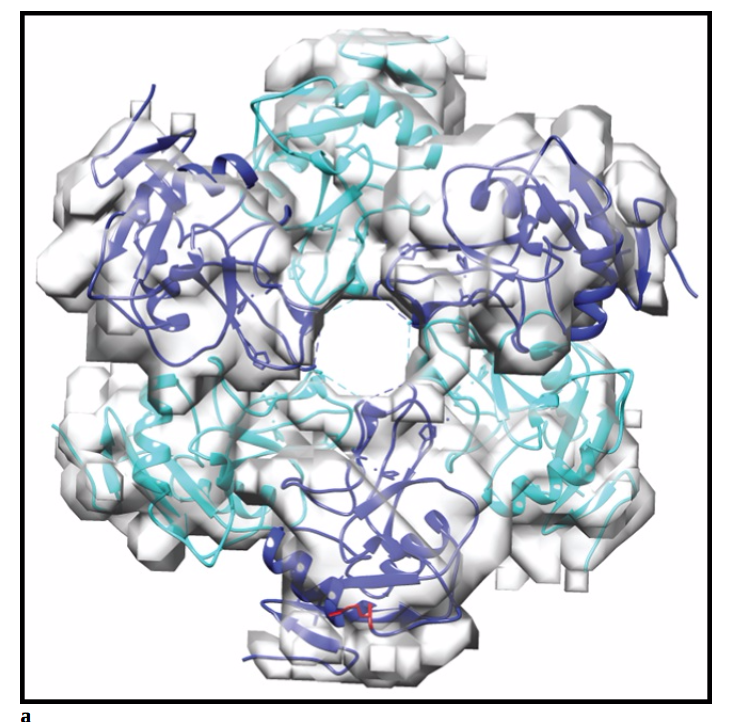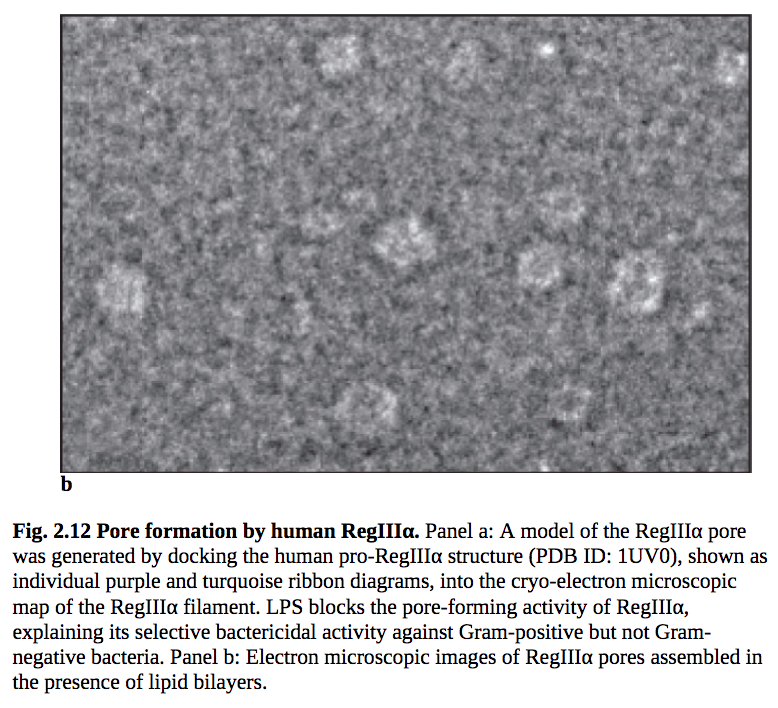【2.4】上皮细胞和吞噬细胞产生多种抗菌分子
我们的表面上皮细胞不仅仅是感染的物理屏障;它们还产生多种杀菌或抑制微生物生长的化学物质。例如,胃的酸性pH值和消化酶、胆汁盐、脂肪酸、,和存在于上消化道中的溶血肽形成了对感染的实质性化学屏障(见图2.5)。一组重要的抗微生物蛋白包括攻击细菌细胞壁特有的化学特征的酶。这种抗微生物酶包括溶菌酶和分泌型磷脂酶A2,它们在眼泪和唾液中以及由吞噬细胞分泌。溶菌酶是一种糖苷酶,可破坏细菌细胞壁肽聚糖层中的特定化学键。肽聚糖由N-乙酰氨基葡萄糖(GlcNAc)和N-乙酰壁酸(MurNAc)的交替残基组成的聚合物网络组成;肽聚糖层由交叉连接这些多糖聚合物的肽桥形成(图2.9)。溶菌酶选择性地切割聚合物两种糖之间的β-,其具有覆盖肽聚糖层的LPS外层。溶菌酶也由Paneth细胞产生,Paneth细胞是小肠隐窝底部的专门上皮细胞,向肠道分泌许多抗菌蛋白(见图2.6)。Paneth细胞也产生分泌型磷脂酶A2,一种高度碱性的酶,可以进入细菌细胞壁,进入并水解细胞膜中的磷脂,杀死细菌。

上皮细胞和吞噬细胞分泌的第二类抗菌剂是茶氨酸杆菌肽。这些是最古老的防御感染的方式之一。这些肽可以由吞噬性免疫细胞(如中性粒细胞)产生,它们可以保留在吞噬颗粒内。它们也由上皮细胞产生,例如在肺部,在那里它们可以分泌到粘膜表面。哺乳动物中三类重要的抗菌肽是防御素、组织蛋白酶和组织蛋白酶。
防御素是一类古老的、进化上保守的抗微生物肽,由许多真核生物(包括哺乳动物、昆虫和植物)制成(图2.10)。它们是约30–40个氨基酸的短阳离子肽,通常具有三个二硫键,稳定一个共同的两亲结构——一个与疏水区分离的带正电荷的区域。防御素会在几分钟内破坏细菌和真菌的细胞膜,以及一些病毒的膜包膜。这种机制被认为是将疏水区域插入到膜双层中,并形成使膜泄漏的孔(见图2.10)。大多数多细胞生物产生许多不同的防御素,植物拟南芥产生13种防御素,果蝇至少产生15种防御素。人类Paneth细胞产生多达21种不同的防御素,其中许多由8号染色体上的一组基因编码。


防御素的三个亚家族-α-、β-和θ-防御素是根据氨基酸序列区分的。每个家族的成员都具有不同的活性,一些对革兰氏阳性菌和一些对革兰氏阴性菌具有活性,而另一些对真菌病原体具有特异性。所有的抗菌肽,包括防御素,都是通过非活性前肽的蛋白水解加工产生的(图2.11)。在人类中,发育中的中性粒细胞通过细胞蛋白酶处理约90个氨基酸的初始前肽来去除阴离子前肽,产生储存在所谓初级颗粒中的阳离子防御素,从而产生α-防御素。中性粒细胞的主要颗粒是专门的膜囊泡,与溶酶体非常相似,含有许多其他抗菌剂和防御素。我们将在第3章中解释,在细胞吞噬病原体后,这些初级颗粒如何被诱导与吞噬小泡(吞噬体)融合,从而帮助杀死微生物。肠道的Panethcells组成性地产生α-防御素,称为隐窝蛋白,在分泌到肠腔之前,这些蛋白被蛋白酶处理,如小鼠体内的金属蛋白酶基质溶素或人类体内的胰蛋白酶。β-防御素缺乏α-防御素的长前体,通常是针对微生物产物的存在而产生的。β-防御素(和一些α-防御素)由肠道外的上皮细胞产生,主要存在于呼吸道和泌尿生殖道、皮肤和舌头。β-表皮角质形成细胞和肺部II型肺细胞产生的防御素被包装成板层体(见图2.6),这是一种富含脂质的分泌细胞器,将其内容物释放到细胞外空间,在表皮和肺部表面活性剂层形成不透水的脂质层。θ-防御素起源于灵长类动物,但人类θ-防御蛋白基因已被突变失活。


属于组织蛋白酶家族的抗菌肽缺乏稳定防御素的二硫键。人类和小鼠有一种猫腻蛋白基因,但其他一些哺乳动物,包括牛和羊,有几种。Cathelicidins由中性粒细胞和巨噬细胞组成,并响应皮肤角质形成细胞和肺和肠上皮细胞的感染。它们被制成由两个连接结构域组成的非活性前肽,并在分泌前进行处理(见图2.11)。在中性粒细胞中,非活性的组织蛋白酶前肽储存在另一种称为次级颗粒的特殊细胞质颗粒中。只有当初级和次级颗粒被诱导与吞噬体融合时,Cathelicidin才会被蛋白水解裂解激活,在吞噬体中,Catheliacidin被储存在初级颗粒中的中性粒细胞弹性蛋白酶释放。裂解分离两个结构域,裂解产物要么留在吞噬体中,要么通过胞吐作用从中性粒细胞释放。羧基末端肽是一种阳离子两亲肽,可破坏膜,对多种微生物都有毒性。氨基末端肽在结构上类似于一种叫做组织蛋白酶L(一种参与抗原加工和蛋白质降解的溶酶体酶)抑制剂的蛋白质,但其在免疫防御中的作用尚不清楚。在角质形成细胞中,cathelicidins,如β-防御素,被储存和加工在板层体内
一类叫做组胺的抗菌肽是由腮腺、舌下腺和下颌下腺在口腔中组成性产生的。这些短的、富含组氨酸的阳离子肽对致病真菌如新生隐球菌和白色念珠菌具有活性。最近,发现组胺能促进口腔典型的伤口快速愈合,但其作用机制尚不清楚
上皮细胞产生的另一类杀菌蛋白是碳水化合物结合蛋白,或凝集素。大多数C型凝集素的碳水化合物识别结构域(CRD)的结合活性需要钙,这为结合碳水化合物结构提供了可变界面。RegIII家族的C型凝集素包括人类和小鼠肠上皮表达的几种杀菌蛋白。然而,RegIII蛋白对碳水化合物的识别不是钙依赖性的,而是受到钙的抑制。在小鼠中,RegIIIγ,由Paneth细胞产生并分泌到肠道中,在肠道中与细菌细胞壁中的肽聚糖结合并发挥直接杀菌活性。与其他杀菌肽一样,RegIIIγ以非活性形式产生,但被蛋白酶胰蛋白酶切割,它去除了一个小的氨基末端片段,以激活肠腔内RegIIIγ的杀菌潜力(见图2.11)。人RegIIIα(也称为HIP/PAP,用于肝癌胰腺/胰腺炎相关蛋白)通过在细菌膜上形成一个大孔直接杀死细菌(图2.12)。RegIII家族蛋白优先杀死革兰氏阳性菌事实上,革兰氏阴性菌的LPS抑制了RegIIIα的成孔能力,进一步增强了RegIII蛋白对革兰氏阳性菌的选择性


最后,我们简要介绍了肽S100A8和S100A9,它们异二聚体形成钙卫蛋白,我们将在第11-11节中在T细胞产生的背景下讨论。钙卫蛋白起到隔离微生物所需的镁和铁的作用,并在其产生部位发挥抗菌作用。这种活性需要钙与钙保护蛋白的两个金属结合位点之一结合,这允许其第二个位点与其他金属离子结合。钙卫蛋白由中性粒细胞和T细胞大量产生,但也由肠上皮细胞产生,这也是先天屏障防御系统的一部分
总结
哺乳动物对入侵生物的免疫反应分三个阶段进行,首先是直接的先天防御,然后是诱导的先天防御和最终的适应性免疫。宿主防御的第一阶段包括那些存在并随时准备抵抗入侵者的机制。上皮表面提供物理,阻止病原体进入,但他们也有其他更专业的策略。粘膜表面有一层保护性的粘液屏障。通过特定的细胞表面相互作用,高度分化的上皮细胞保护微生物的定植和入侵。上皮细胞的防御机制包括防止病原体粘附、分泌抗微生物酶和杀菌肽,RegIII家族的抗菌肽和杀菌凝集素是一种无活性的前蛋白,需要蛋白水解步骤才能完成其活化,因此它们能够通过在微生物细胞膜上形成孔来杀死微生物。本章这部分描述的抗微生物酶和肽的作用通常涉及与微生物上独特的聚糖/碳水化合物结构的结合。因此,这些可溶性分子防御同时是模式识别受体和效应分子,代表了最简单的先天免疫形式
- Glossary : pathogenic microorganism Microorganism that typically causes disease when it infects a host.
- pathogen: Microorganism that typically causes disease when it infects a host.
- pathogenesis: The origin or cause of the pathology of a disease.
- immune evasion: Mechanisms used by pathogens to avoid detection and/or elimination by host immune defenses.
- exotoxin: A protein toxin produced and secreted by a bacterium.
- endotoxins: Toxins derived from bacterial cell walls released by damaged cells. They can potently induce cytokine synthesis and in large amounts can cause a systemic reaction called septic shock or endotoxic shock.
- lipopolysaccharide (LPS): The surface lipopolysaccharide of Gram-negative bacteria, which stimulates TLR-4 on macrophages and dendritic cells.
- Gram-negative bacteria: Bacteria that fail to retain crystal violet stain after alcohol wash because of a thin peptidoglycan layer.
- zoonotic: Describes a disease of animals that can be transmitted to humans.
- mucosal epithelia: Mucus-coated epithelia lining the body’s internal cavities that connect with the outside (such as the gut, airways, and vaginal tract).
- mucus: Sticky solution of proteins (mucins) secreted by goblet cells of internal epithelia, forming a protective layer on the epithelial surface.
- mucins: Highly glycosylated cell-surface proteins. Mucin-like molecules are bound by Lselectin in lymphocyte homing.
- cystic fibrosis: Disease caused by defect in the CFTR gene, leading to abnormally thick mucus and causing serious recurrent infections of the lung.
- commensal bacteria: Microorganisms (predominantly bacteria) that normally live harmlessly in symbiosis with their host (e.g., the gut bacteria in humans and other animals). Many commensals confer a positive benefit on their host in some way.
- microbiota: Microorganisms (predominantly bacteria) that normally live harmlessly in symbiosis with their host (e.g., the gut bacteria in humans and other animals). Many commensals confer a positive benefit on their host in some way.
- inflammatory response: General term for the local accumulation of fluid, plasma proteins, and white blood cells that is initiated by physical injury, infection, or a local immune response.
- lysozyme: Antimicrobial enzyme that degrades bacterial cell walls.
- peptidoglycan: A component of bacterial cell walls that is recognized by certain receptors of the innate immune system.
- Paneth cells: Specialized epithelial cells at the base of the crypts in the small intestine that secrete antimicrobial peptides.
- defensins: See α-defensins, β-defensins.
- cathelicidins: Family of antimicrobial peptides that in humans has one member.
- histatins: Antimicrobial peptides constitutively produced by the parotid, sublingual, and submandibular glands in the oral cavity. Active against pathogenic fungi such as Cryptococcus neoformans and Candida albicans.
- amphipathic: Describes molecules that have a positively charged (or hydrophilic) region separated from a hydrophobic region.
- propeptide: Inactive precursor form of a polypeptide or peptide, which requires proteolytic processing to produce the active peptide.
- α-defensins: A class of antimicrobial peptides produced by neutrophils and the Paneth cells of the intestine.
- primary granules :Granules in neutrophils that correspond to lysosomes and contain antimicrobial peptides such as defensins and other antimicrobial agents.
- cryptdins: α-Defensins (antimicrobial peptides) made by the Paneth cells of the small intestine.
- β-defensins: Antimicrobial peptides made by virtually all multicellular organisms. In mammals they are produced by the epithelia of the respiratory and urogenital tracts, skin, and tongue.
- lamellar bodies: Lipid-rich secretory organelles in keratinocytes and lung pneumocytes that release βdefensins into the extracellular space.
- secondary granules: Type of granule in neutrophils that stores certain antimicrobial peptides.
- neutrophil elastase: Proteolytic enzyme stored in the granules of neutrophils that is involved in the processing of antimicrobial peptides.
- cathelin: A cathepsin L inhibitor.
- lectin: A carbohydrate-binding protein.
- C-type lectins: Large class of carbohydrate-binding proteins that require Ca2+ for binding, including many that function in innate immunity.
- HIP/PAP: An antimicrobial C-type lectin secreted by intestinal cells in humans. Also known as RegIIIα.
- calprotectin : A complex of heterodimers of the antimicrobial peptides S100A8 and S100A9, which sequester zinc and manganese from microbes. Produced in abundance by neutrophils and in lesser amounts by macrophages and epithelial cells. secretory phospholipase A2 Antimicrobial enzyme present in tears and saliva and also secreted by the Paneth cells of the gut.
- RegIIIγ : An antimicrobial protein of the C-type lectin family, produced by Paneth cells in the gut in mice.
参考资料
- Janeway’s Immunobiology 10th edition
